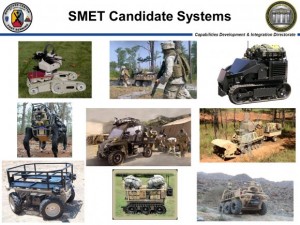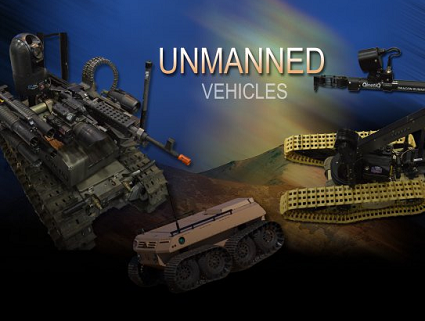Army Robotics, Unmanned Tech on the March
Burney Simpson
It’s not called March for nothing.
The U.S. Army this month actively pushed its robotics and autonomous vehicle programs as it tests new equipment and looks for ways to replace men with machines.
Here’s a roundup:
The leader of the army’s robotics group argued that a ‘robotics vanguard’ could replace human soldiers during certain offensive maneuvers.
“There’s no reason why the first contact with an enemy force should be with a man-platform, because it means that platform is at the greatest risk,” Dr. Bob Sadowski said at a robotics conference in March in Springfield, Va., the Army reported.
Sadowski is the robotics leader with the U.S. Army Tank Automotive Research Development and Engineering Center, (TARDEC), in Warren, Mich.
TARDEC oversees the Army’s manned and unmanned ground vehicle systems, and combat service support equipment.
A first offense robot could save lives while providing intelligence on enemy positions, Sadowski said.
TWO ARMS ARE BETTER THAN ONE
The conference also saw a display of a two-armed robot that can diffuse bombs.
Hau Do, leader of a TARDEC robotics development team, noted his group is working with Carnegie Mellon spinoff RE2 Robotics on the project.
The Army now uses one-armed robots to diffuse bombs but they leave a little to be desired.
“Have you ever tried unscrewing a water bottle cap with one arm? You can’t,” Hau Do told the Army press office.
Partners will be able to catch up at TARDEC Industry Days April 26-27, in Warren, Mich.
 EQUIPMENT TRANSPORT
EQUIPMENT TRANSPORT
The Army is reviewing the Squad Maneuver Equipment Transport (SMET), an autonomous or semi-autonomous, vehicle that carries the equipment soldiers need on a 72-hour patrol. The SMET might also be used for perimeter defense once a base is established.
Precise specs haven’t been written, but the vehicle will be powered by a rechargeable battery that can also charge the soldiers equipment as necessary.
The vehicle must be large enough to carry the equipment but small enough to fit in a helicopter, and move through a jungle.
SILICON VALLEY COLLABORATION
Secretary of Defense Ash Carter visited Silicon Valley in March as the Pentagon sought to strengthen its ties with the tech industry. Carter has promoted the 3rd Offset Strategy that relies on new technology to offset enemy advantages in troop size or other strengths.
Eric Schmidt, executive chairman of Google parent Alphabet, was named the chief of an advisory panel that will provide the Defense Department with innovative ideas being developed in the Valley.
Schmidt, who was the only announced panelist, said he had a list of possible members to call.
Carter also gave a boost to collaborative industry/military projects launched last year under the ARCYBER name. These are designed to counter social media threats by various enemies.
One new approach is the teaming of 10 Army cyber (hence ARCYBER) experts with their Silicon Valley counterparts.
In April, a Hacking4Defense program will begin at Stanford University. Students will work with reps from the DoD and various intelligence agencies to apply ‘lean startup principals’ when creating social media products.
Last year’s Army Cyber Innovation Challenge led to vendors supplying defensive infrastructure kits that protect Army cyber protection teams. This month, the Army plans to begin a challenge designed to foment new software that will manage its cloud computing systems.


